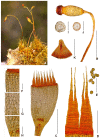Undiscovered Biodiversity of the European Moss Flora: Neodicranella hamulosa (Aongstroemiaceae), a New Genus and Species from SW Portugal
- PMID: 34834650
- PMCID: PMC8621727
- DOI: 10.3390/plants10112289
Undiscovered Biodiversity of the European Moss Flora: Neodicranella hamulosa (Aongstroemiaceae), a New Genus and Species from SW Portugal
Abstract
A new genus is described to accommodate Neodicranella hamulosa, a novel species resolved in the family Aongstroemiaceae, from the Monchiquense district in SW Portugal. Characterized by its small size, erect spreading to subsecund non-sheathing leaves, plane bistratose leaf margins, and rhizoidal gemmae with slightly protruberant cells, it differs from all other European Dicranellaceae in the uniquely patterned distal peristome segments with backward-pointing papillae resembling hooked barbs. The species appears to be endemic to the sub-Mediterranean bioclimatic zone, in wooded biomes where humidity remains relatively high throughout the year. Morphological and molecular data strongly support the singularity of this new taxon. The species is illustrated by photomicrographs and SEM, and its ecology and conservation are discussed.
Keywords: Dicranella; European moss endemic; Nad5; algarve; bayesian phylogenetic analysis; rps4; serra de monchique; taxonomy; trnL-trnF.
Conflict of interest statement
The authors declare no conflict of interest.
Figures








Similar articles
-
New Taxonomic Arrangement of Dicranella s.l. and Aongstroemia s.l. (Dicranidae, Bryophyta).Plants (Basel). 2023 Mar 17;12(6):1360. doi: 10.3390/plants12061360. Plants (Basel). 2023. PMID: 36987046 Free PMC article.
-
Marsupella lusitanica (Gymnomitriaceae, Marchantiophyta), a New Species of Sect. Ustulatae from Mountain Ranges of Portugal.Plants (Basel). 2023 Mar 27;12(7):1468. doi: 10.3390/plants12071468. Plants (Basel). 2023. PMID: 37050094 Free PMC article.
-
Zygodon Hook. ex Taylor a new record to Libya.Pak J Biol Sci. 2009 Dec 15;12(24):1571-5. doi: 10.3923/pjbs.2009.1571.1575. Pak J Biol Sci. 2009. PMID: 20334118
-
DNA barcoding and traditional taxonomy: an integrated approach for biodiversity conservation.Genome. 2017 Jul;60(7):618-628. doi: 10.1139/gen-2015-0167. Epub 2017 Apr 21. Genome. 2017. PMID: 28431212 Review.
-
Plant reproductive ecology and evolution in the Mediterranean islands: state of the art.Plant Biol (Stuttg). 2018 Jan;20 Suppl 1:63-77. doi: 10.1111/plb.12636. Epub 2017 Oct 29. Plant Biol (Stuttg). 2018. PMID: 28945322 Review.
Cited by
-
New Taxonomic Arrangement of Dicranella s.l. and Aongstroemia s.l. (Dicranidae, Bryophyta).Plants (Basel). 2023 Mar 17;12(6):1360. doi: 10.3390/plants12061360. Plants (Basel). 2023. PMID: 36987046 Free PMC article.
-
Marsupella lusitanica (Gymnomitriaceae, Marchantiophyta), a New Species of Sect. Ustulatae from Mountain Ranges of Portugal.Plants (Basel). 2023 Mar 27;12(7):1468. doi: 10.3390/plants12071468. Plants (Basel). 2023. PMID: 37050094 Free PMC article.
References
-
- Frey W., Stech M. Division Bryophyta Schimp. (Musci, Mosses) In: Frey W., editor. Syllabus of Plant Families, Part 3: Bryophytes and Seedless Vascular Plants. Gebrüder Borntraeger; Stuttgart, Germany: 2009. pp. 116–257.
-
- Crosby M.R., Magill R.E., Allen B., He S. A Checklist of the Mosses. Missouri Botanical Garden; St. Louis, MO, USA: 2000. pp. 1–320.
-
- Gradstein S.R., Churchill S.P., Salazar-Allen N. Guide to the Bryophytes of Tropical America. New York Botanical Garden Press; New York, NY, USA: 2001. Memoirs of the New York Botanical Garden; pp. 1–577.
-
- Larraín J., Suárez G., Bednarek-Ochyra H., Ochyra R. The rediscovery of Dicranella circinata (Dicranellaceae, Bryophyta), with comments on other southern South American species of Dicranella. Nova Hedwig. 2010;91:361–376. doi: 10.1127/0029-5035/2010/0091-0361. - DOI
-
- Carmo D.M., Peralta D.F. Sinopse do gênero Dicranella (Müll.Hal.) Schimp. (Dicranellaceae, Bryophyta) para o Brasil com lectotipificações e citações de novas ocorrências. Pesqui. Botânica. 2020;74:249–282.
LinkOut - more resources
Full Text Sources
Miscellaneous

